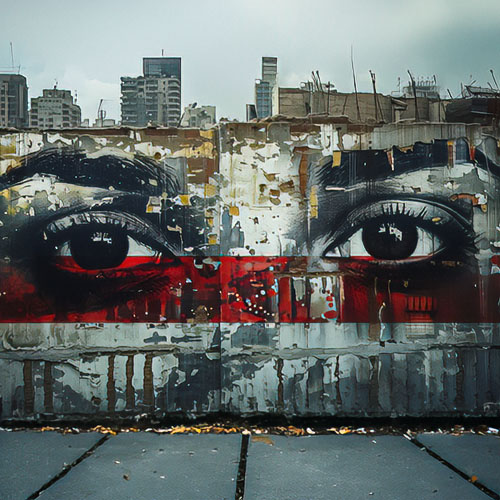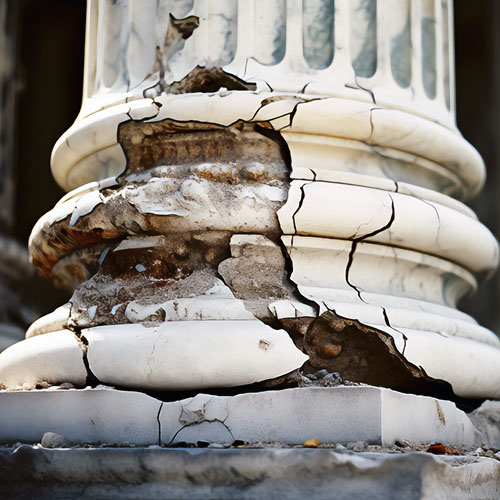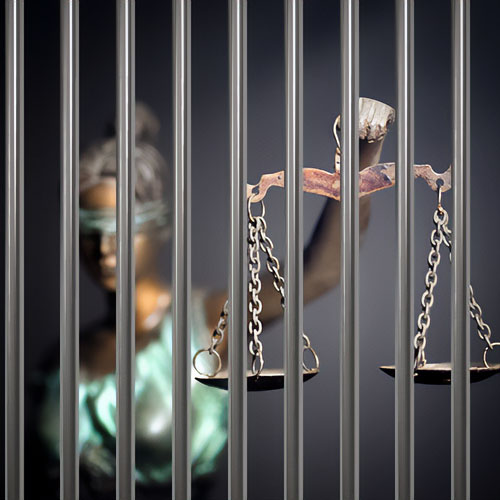Go in-depth with the unspeakable horror of prison life that everyone knows about, but no one wants to control.
Prison Rape
Even through the grimy window of the Corrections Department van, David Aldred could see trouble waiting for him.
The van had just arrived at the reception gate of the Glades Correctional Institution in Belle Glade, Florida. A fresh load of state prisoners was aboard. Aldred, a wiry 22-year-old with wavy brown hair, had the seat behind the driver. His hands were cuffed together. He was squinting into the harsh Florida sun. But as Aldred peered out the van’s side window, he could see clear to the other side of a tall, chain-link fence, where a group of inmates had gathered in the prison yard.
A hundred and fifty of them? Two hundred? It was hard to say for sure. But they certainly seemed excited about something. Several of the prisoners were banging on the fence. Others were shouting in the direction of the van. But with the doors of the vehicle still closed, Aldred couldn’t make out the prisoners’ words. Not yet.
What is this? he thought nervously to himself. The welcoming committee?
As a guard came out and opened one of the van’s side doors, Aldred’s initial nervousness quickly grew into something more resembling fear. The shouting was growing louder, and now Aldred could make out the words.
“Look at the pretty white boy,” he heard one prisoner yell.
“He’s mine,” someone else called out. “I want to get some of that.”
“I saw him first.”
“No, he’s mine.”
“Look at the ass on that one,” another prisoner shouted. “Hey, Lieutenant, I want that one in my dorm.”
As Aldred and the other newcomers were walked into their new high-security home, serenaded by this excited chorus of whoops and taunts, quite a few thoughts were racing around in David Aldred’s head. But none of those thoughts was anywhere near as pressing as this:
Please, God, he said to himself. I hope they’re not talking about me.
The threat of forced sex in prison — is anything more terrifying?
Bad enough that you got arrested and sent off to jail. Bad enough that you’ll be separated from family and friends. Bad enough that a bunch of dim-witted prison guards will be telling you when to get up in the morning and when to go to sleep at night.
But none of that — none of it — rattles the male psyche like that other dark jail-house threat: Some 250-pound gorilla has decided to make you his girlfriend. And he’s not taking no for an answer.
Holy shit! Don’t let rape happen to me!
But it does happen. More often than prison officials are ever willing to acknowledge. More often than most people on the outside ever dare to guess. Add AIDS to the equation. All of a sudden, you’re not just talking anger, pain, and humiliation. You’re talking life and death.
Yet almost nobody has shown much inclination to confront this unspeakable taboo. Not the courts. Not Congress or most of the state legislatures. Certainly not the so-called corrections professionals who run our prisons and jails. They barely admit the problem exists. It is instead locked away, where it cannot be seen. It stays behind high walls, where it can easily be denied. It is destroying a group of men nobody much cares about anyway.
So hold on tight now. We are heading into nightmare territory. David Aldred will show us around.
It didn’t take long for Aldred to find out whose ass the welcoming committee was whooping for. His second night at the Glades Correctional Institution, he walked to the shower from his bunk in B-dorm. He was standing under the chilly water and had just lifted a washcloth to his face. The next thing he felt was a powerful whack on the side of his head, behind his right ear. The blow caught him by surprise and sent him slumping against the wall of the shower. Then he felt a strong pair of hands push him to the hard, wet floor.
His attackers held him spread-eagled, face down. One of them grabbed a handful of Aldred’s hair and yanked his head back hard. Then a knife was jammed against Aldred’s throat.
Lying on the shower floor like that — his head pulled back, a knife at his throat, his bare butt fully exposed — Aldred never got a clear look at his attackers. He couldn’t even tell for sure if there were two of them or three. But from behind his head, he heard a warning he understood perfectly. “If you open your mouth or holler, you will die.”
He didn’t need to hear it twice.
His legs were spread, and Aldred was raped from behind. Several times. Altogether, as close as he could estimate, the attack lasted 15 or 20 minutes. That whole time, Aldred was on the shower floor, writhing in excruciating pain. The lower part of his body, he would recall later, felt just like it had been ripped apart and set on fire.
Finally, his attackers were finished. Without another word, they pulled themselves off him and walked back toward the dorm.
No one knows exactly how many men are raped in America’s jails and prisons every year. In fact, no professional researcher has ever conducted a national survey on the subject. When it comes to prison-rape statistics, all we have to go on are a few small studies that have been conducted here and there.
“For a topic like this not to be studied is just incredible,” says Cindy Struckman-Johnson, a professor at the University of South Dakota and a leading expert on prison rape. “But it is extremely difficult to get grant money to do this kind of research. We still don’t have people talking about this. A major crime against humanity, we just tolerate. We think when people go to jail, it’s okay for this to happen to them.”
Until recently, the most rigorous study was conducted by researchers Wayne Wooden and Jay Parker, in 1980. Focusing on a medium-security prison in California, they found that 14 percent of the inmates had been “pressured into having sex against their will,” a figure the researchers said was probably an undercount. In a 1975 study of six prisons in New York State, researcher Daniel Lockwood found that 28 percent of the inmates had been targets of sexual aggression. And Lockwood discovered that younger prisoners seemed to have it worst of all. At one juvenile prison, 71 percent of the young males said they had been targeted for sexual abuse.
Struckman-Johnson is just now completing what will be the largest study yet of rape behind bars. Her research covers only the state of Nebraska. The preliminary results? Several points higher than Wooden’s and Parker’s 14 percent.
It is possible to extrapolate from these small studies and hazard a rough guess about how many prisoners across America are victims of sexual aggression every year. Start with that conservative estimate of 14 percent. Multiply that by the 1.3 million men sitting behind bars right now. You end up with a staggering total: 182,000 victims a year. That’s 15,166 a month; 3,500 a week; 498 victims every day.
So who are these men?
Well, for months now, I’ve been getting letters from them, taking their collect calls, and meeting with them in prison visiting rooms. I had put out word to a few old prison sources that I wanted to talk to men who had been sexually assaulted behind bars, victims of male-on-male, inmate-on-inmate rape.
This, obviously, is not the easiest topic for most men to discuss. It is especially dicey in the macho prison world, where the rat is considered the lowest form of human life. But despite the dangerous subject matter, I was inundated with replies-eye-opening replies. Almost without exception, these men told gut-wrenching stories in vivid detail, some of it almost impossible to read or listen to. It was as if a whole army of men had been waiting silently, their anger and their helplessness building up, desperately hoping that somebody, someday, might ask.
They told of gang rapes occurring under the eyes of prison guards. They recounted sexual torture that, for some, went on for years. They described how cell-block threats and mind games could turn a vulnerable heterosexual into the virtual sex slave of another man.
They explained how racial tensions in prison were magnified by disputes over sexual control. They used old prison-yard expressions like punks, Jockers, and queens. And, time after time, they described the bureaucratic brick walls that prisoners keep running into whenever they try to complain.
“No, it doesn’t happen to everybody, but it is far more common than people think — people on the outside, that is,” says Richard Swanson, director of programs for the Colorado Department of Corrections. Swanson is one of the few prison administrators in America who speaks out publicly about inmate-on-inmate rape.
Over the years, Swanson says, certain patterns have emerged. “In general,” he says, “the younger you are, the smaller you are, the whiter you are, the more likely you are to be victimized.” It’s the familiar old story of the powerful taking advantage of the weak — the physically weak, the psychologically weak, the numerically weak.
Whites may still run the outside world, but other groups often dominate the numbers behind prison walls. And as Swanson puts it, “No expression of that power is more potent — or more degrading to the victim — than a forced sexual assault.”
The vast majority of these victims, Swanson and other experts have found, are heterosexual men. But something else is even more interesting in this regard. Most prison rapists believe they are straight, even as they force themselves on other men.
“In the culture of prison,” Swanson says, “the rapists typically see themselves as heterosexual. They might view their own victim as gay, or weak, or somehow asking for it. But it’s still, ‘I am the man.’”
David Aldred didn’t lie on that shower floor for long. He caught his breath. He hoisted himself up. He went back to his bunk and pulled on some clothes. For the next 45 frenzied minutes, he went stomping around B-dorm, hunting for the men who had done this terrible thing to him. He surveyed the faces of other inmates, looking for some kind of sign, something he might remember or recognize. He listened carefully for voices, hoping he might catch someone bragging about what had occurred.
He came up empty. So he did the only other thing he could think of to do. He approached one of the dormitory officers and tried to report the rape.
“Go back to your bunk,” was all the officer told him. “I’ll take care of it.”
But, apparently, the dorm officer did nothing. He didn’t put Aldred into protective custody. He didn’t order a medical exam. He didn’t even file a report. At midnight, when the guard-shift changed, Aldred was still waiting for word. He asked the night man what was happening with his complaint. “Your complaint?” the night man asked. He didn’t know what Aldred was talking about.
Aldred waited until morning, when the guards’ lieutenant arrived. Again, he tried to report the attack.
The lieutenant asked who the assailants were. Aldred said he had heard a voice, but he couldn’t say for sure. He asked for protective custody. The lieutenant said no. What he did offer Aldred was a single piece of advice. “You got to start being a man sometime,” the lieutenant said.
And that, as far as the Glades Correctional Institution and the state of Florida were concerned, was pretty much that.
David Aldred didn’t know it yet, but it was the same response that prison-rape victims had been getting for years — the only response that most of them ever get. It was that eloquent but dull-faced reaction that can be summed up in a shrug and two little words: “Tough luck.”
Nobody, it seems, ever wants to come to grips with the issue of prison rape. Nobody. Not state or federal prosecutors. Their informal motto is, “If you can’t do the time, don’t do the crime.” It’s true, sexual assault is a serious crime, wherever it occurs. That’s what the law books say, anyway. Nonetheless, prison rapists are almost never prosecuted. The cases just aren’t brought. Sometimes this is because inmates fear reprisals if they make complaints. But even when cases are brought to the prosecutor’s door, they are most often pushed aside, treated like simple disputes among bad guys who probably deserve one another.
Not the courts. If prison rape isn’t “cruel and unusual punishment,” what is? But the nation’s judges have made it extremely tough for a prison-rape victim to get legal relief. The obvious answer would be to encourage prison victims to sue their jailers for failing to protect them. Prisoners, after all, are sentenced to time — not to rape. But the Supreme Court has made such lawsuits extremely difficult.
“Most prison rapists believe that they are straight, even as they force themselves on other men.”
Not the people who run our prisons and jails. Some of them will agree, in the abstract, that non-consensual sex is often a fact of life behind bars today. But good luck trying to find a single warden who will admit that, yes, such things go on behind his prison walls. Instead, prison officials are more likely to discourage the reporting of sexual assaults, and block publicity of any sort. (That was certainly the case when I researched this piece.) Some critics contend that prison officials tacitly approve or actually encourage a certain amount of inmate-on-inmate sexual abuse. It’s a good “management tool,” they say — helpful in keeping an institution under control.
Not the media. Prison rape is still generally considered too grisly a topic for the network news magazines, too much of a downer for most glossy magazines. A Washington Post reporter did win the Pulitzer Prize in 1983 for a series on prison rape, and The Boston Globe did a series two years ago. But rarely does the subject pop up in the media at all. We may well be talking here about America’s last, undiscovered victim class, ignored by even Oprah, Maury, and Phil.
Not the universities and foundations. We’re talking here about convicted criminals, a group that doesn’t generate much sympathy from the usual do-good groups. As Cindy Struckman-Johnson and her colleagues have discovered, it is just about impossible today to get grant money to study prison rape.
Not the anti-rape activists. They’ve managed to turn male-on-female rape into a major social cause. But when it comes to the male-on-male kind, especially behind bars, these energetic activists suddenly run out of steam. They don’t even like to discuss the obvious connection between the two kinds of rape — what psychologists call the recurring cycle of abuse. Heterosexual men who are raped in prison come out as potential rapists themselves — targeting women, not men.
To all these groups and institutions, it’s almost as if the shameful epidemic of prison rape doesn’t exist. And it doesn’t, as far as the U.S. Bureau of Justice Statistics is concerned. That’s the federal agency that collects crime numbers for the government. You can add the bureau’s name to the long list of those who’ve shown they aren’t concerned. Their official count of crime in America doesn’t include incidents that occur in prison or jail. It simply does not.
In the end, all these groups have been able to skate around this issue perfectly well, secure in the knowledge that whatever might happen behind prison bars, few people are likely to see it, and even fewer are likely to mind.
Amid this deafening silence, a few brave voices have occasionally been heard. The Prison Project of the American Civil Liberties Union has brought a few lawsuits on behalf of prison-rape victims. Public defenders and private attorneys have joined the fight here and there. And the New York State Council of Churches has produced two excellent cassette tapes on the subject of prison rape which are distributed through the council’s Safer Society Press. One tape, in extremely frank language, advises new prisoners on how to protect themselves from cell-block predators. The other offers sound advice on how prison administrators can keep their institutions rape-free.
Then there is Stephen Donaldson, the man behind a small organization called Stop Prisoner Rape. If this dark issue has its beacon of hope, its lonely crusader fighting terrible odds, Donaldson would have to be it.
With his horn-rim glasses and his long sideburns, Donaldson does not come to this issue by any philosophical or ideological route. Back in 1973, he was a Columbia College graduate and a Navy veteran, active against the Vietnam War. Arrested during a Quaker “pray-in” at the White House, Donaldson refused to post the $10 bail and was tossed in the District of Columbia jail. During his two-day stay, he was the victim of an extraordinarily vicious rape — attacked by a huge mob of inmates.
“If a prisoner is middle class, if he isn’t particularly street-smart, if he’s not a member of a gang, and if he doesn’t belong to whatever happens to be the dominant racial group inside — that’s the kind of person who’s most vulnerable,” he says. “I was a perfect target.”
As might be expected, that event set off some serious turmoil in Donaldson’s life. He was back to prison twice — four years for attempted murder, six months for a parole violation. But the rape also set Donaldson off on his current course: a passionate campaign to protect others from the horror that befell him.
He lobbies government officials. He tries to talk sense to prison administrators. He drafts legal briefs. He forcefully nudges the occasional reporters who wander by. He dreams up new and different ways to get this unattractive issue in the public eye.
“There is so much society could do about this, and a lot of it isn’t even very expensive,” says Donaldson, who is 47 now and lives in New York City, a few blocks from his alma mater. “Just training prison guards how to deal with someone who’s just been raped — that would make a tremendous difference. Separating violent and nonviolent prisoners — that would help, too.”
But the first step, Donaldson says, is somehow getting the outside world to pay attention. “The attitude has always been, ‘These guys are in prison for a reason, aren’t they?’ ” he says. “And that’s true. But what kind of society turns its back on a human violation like this, even if the victims aren’t the most sympathetic people around? But it is easier for society to just pretend these people don’t exist. Most people worry about this only when they are going to prison — or when they care about somebody who is.”
Yet the costs of not dealing with prison rape are far greater than anyone wants to admit — and not just for the prisoner. “You take a guy who’s been raped in prison,” Donaldson says. “He is going to be filled with a tremendous amount of rage. It’s almost as if his manhood has been taken away. Now, eventually, he’s probably going to get out. Most people do. And all the studies show that today’s victim is tomorrow’s predator. So by refusing to deal with this in an intelligent way, you are genuinely sentencing society to an epidemic of future rapes. Only now, these rapists aren’t looking for male victims anymore. They are looking for females now — in a misguided attempt to recapture their manhood.”
Donaldson firmly believes that prisoners themselves must play a crucial role in rooting out the problem of prison rape. Today, he says, far too many prisoners look the other way. Until that attitude changes, sweeping institutional solutions are unlikely to take hold. “Prisoners have to learn to respect themselves and each other,” Donaldson says.
David Aldred never forgot what happened to him in the shower that night at Glades. Which, considering the ferocity involved, is no big surprise. What is surprising is the sequence of events that followed Aldred’s rape — and the fleeting glimmer of optimism those events offered to prisoners everywhere.
Aldred, it turned out, wasn’t the only Glades prisoner who reported being sexually assaulted. In fact, when it came to sexual violence and coercion, Glades was deluged with such complaints.
Eventually, a prisoner named Anthony LaMarca filed a lawsuit over conditions at Glades, claiming he and his fellow prisoners were being subjected to “cruel and unusual punishment.” The case started small, with a short, hand-written petition to the federal court in Miami. LaMarca himself wasn’t raped, although he did suffer various other kinds of abuse. And he was ultimately joined in his lawsuit by nine other prisoners, including David Aldred. Each of them had a chilling story to tell.
The case took a full four years to get to court. But it was finally heard by Federal Magistrate Peter Nimkoff. Over the course of two long weeks, the prisoners came to the witness stand, 13 of them in all. One by one, they laid out a terrifying tableau: ever-present violence, rampant sexual abuse, guards who ignored and even seemed to encourage horrible things, and administrators who didn’t seem to care.
One prisoner told how he was raped at knife-point in a bathroom in the classification building. Another described being sexually assaulted with a baseball bat in the prison yard, in broad daylight. Aldred and several others testified to the scary welcome they had received as they stepped off the prison van.
One inmate told how he was forced to give blowjobs inside a prison trailer in which porno movies were screened each Saturday night. Another told how he had tried to warn newcomers about the prison’s predators — and was almost killed for his trouble.
As the prisoners testified, the magistrate seemed sympathetic. But what exactly could he do? The brutal inmates were not, after all, government employees. Could the state of Florida be held liable for their vicious acts? The U.S. Supreme Court had already addressed that question in previous cases. The court’s answer was, “generally, no.”
For inmates to win such a lawsuit, the court had decreed, they had to prove that the guards and the warden had showed a “deliberate indifference” to the safety of each individual inmate. That would be extremely hard to prove.
But they managed to do it.
After the magistrate listened to David Aldred and his friends — and watched the Florida prison officials bob and weave on the stand — a quiet piece of legal history was made. It took the magistrate 135 pages to detail all the atrocities he had found packed inside this one Florida prison. Then U.S. District Judge James C. Paine incorporated huge chunks of the magistrate’s report in a blistering decision in the case.
“Considered as a whole,” Judge Paine wrote, “this evidence shows that plaintiffs’ claims possess a factual congruity of sickening proportion. Their stories are strikingly similar, reflecting common experiences of harassment, threats, attack, official indifference, and resulting damage.”
The judge made special mention of the Glades welcoming committee and of the porno trailer on prison grounds. “Uncontradicted evidence shows that sexually explicit videotapes — with graphic depiction of intercourse — were regularly shown in a trailer on the compound, that these movies were unsupervised, and that sounds consistent with human sexual activity could be heard from the trailer.”
The physical layout of the prison dorms, the judge noted, made it nearly impossible for guards to see what was going on, even had they wanted to. Inmates often hung blankets from their upper bunk beds, blocking all view of the lower bunks. The shower was a particular trouble spot, the judge said. “It was impossible for an officer to view activities occurring in the shower.”
“Heterosexual men who are raped in prison come out as potential rapists themselves — targeting women, not men.”
The judge added, “The record contains no evidence that the rapes, which the Magistrate found to have occurred, were even minimally investigated.”
“All this evidence,” the judge wrote, “should have made it apparent to a prudent administrator that rapes were occurring, and that, considering this knowledge, the failure to promulgate and adhere to the most rudimentary investigative and preventative procedures constitutes a deliberate indifference toward inmates’ security.”
Then the judge did something that had never in the history of the United States been done before — he gave the inmates a cash award. The total came to $178,500, to be divided among the prisoners who had sued.
By the time David Aldred and I finally sat down together, he was out of prison — six years, 19 days, and 11 and a half hours after he had first gone in — not that he was counting or anything. We met at a restaurant in Leesburg, Florida, a fly-speck of a town due west of Daytona Beach. The restaurant was just beyond the parking lot of the Scottish Inn motel, where Aldred and his new wife had been living for a couple of months.
He was wearing jeans and a T-shirt that day. His hair was wavy and thick. He laughed and told funny stories about himself. When the waitress came with the Mexican food and beers, he flirted sweetly with her.
But all of that was in the free world. I had come to Florida to hear about life on the other side of the wall. By the time the waitress brought our second beers, I steered the conversation to the Glades Correctional Institution and how events there had affected one young man. If I was expecting mellow forgiveness, I was in the wrong town.
“To survive in prison,” Aldred said, his tone darkening fast, “most of the time, it’s what they call fuck or fight. I would rather die first.” He meant that, I believe.
“All this shit affected me so bad,” he said. “I can’t remember the feeling I felt back then. Now all I feel is hatred, extreme hatred — at the justice system, at the Department of Corrections, at the people that actually did this to me, at all the other people that had to look the other way so it could happen.”
“For the people that actually did this,” he continued, “my hatred is so bad, I would — could — put a gun between their eyes and pull the trigger. I wouldn’t feel shit. Not a thing.”
But to do that, he said, would be to let these people defeat him one more time. “What difference would it make now? I wouldn’t benefit from it. I’d just be going back to jail again, and that is something I definitely am not about to do.”
As we spoke, he said his life was really quite pleasant, the best it had been in years. He had a woman who loved him. He had friends to hang around with. There was a pool at the motel. But the memories, he said, were still showing up at the strangest times. “I can be making love to my wife,” he said, “she can grab both the cheeks of my ass, and it’ll hit me — wham’ All of a sudden, in my mind, I’m back in prison. It fucks me up. The hardest thing I ever did was tell my wife about this.”
Some papers came from the lawyer one day, and he dumped them in her lap. “I told her to read it, and remember this wasn’t my choice to make. It really upset her. She was able to see exactly what I was going through. It wasn’t just a bunch of bullshit. It was something very serious and very real.”
When Aldred and I spoke that day in the restaurant, he hadn’t gotten his money yet. The case was on appeal then, and because of various legal technicalities, some of it was going to have to be retried. Aldred said he was growing pessimistic about the prospect of ever seeing a dime. “You think I’ll get any of that money?” he had asked more than once. I told him I thought he probably would. “The courts can be real slow,” I said.
But David Aldred, as it happened, knew more about the criminal-justice system than I had given him credit for. He never got one penny of what the judge awarded him.
The prison-rape case was retried in federal court, before a jury this time.
In harrowing detail, the inmates laid out what had happened to them, the same chilling stories that had so moved the magistrate and the judge. But this time, in less than an hour, the jury tossed out everything the inmates had said, everything found in the first trial. They found entirely for the prison superintendent and his guards.
In the process, of course, the hopes of a few prisoners and former prisoners were dashed. Not that too many people really seemed to care.
These were prisoners we were talking about, people who had committed crimes. If they couldn’t do the time … well, you know how that goes.
“I think it’s the sentiment of the time regarding crime — a general disgust of crime, defendants, prisoners,” says David Lipman, the lawyer who represented the prisoners in the case.
The lawyer for the Glades administration sees it differently. “Prisons are inherently dangerous places,” he says.
David Aldred could tell him about that.
FIGHTING THE CRUELTY of PRISON RAPE in TWELVE PRACTICAL STEPS
- Remove the easiest prey. Young, nonviolent first-timers — especially those under 25 — should be separated from the tougher cons.
- End the surprises. New prisoners deserve a realistic orientation before they arrive in general population. This must include a frank discussion of prison rape.
- Train the staff. Guards, counselors, and wardens must be taught to deal honestly with prison rape — and to stop denying it.
- Take complaints seriously, even if the prisoners won’t name names. And make “protective custody” protective again. Today it’s often more like punishment.
- Prosecute. Rape is a serious crime wherever it occurs. Police and prosecutors should treat it that way.
- De-stigmatize victims. Being raped doesn’t mean that you’re gay or that you’ve lost your manhood. But rape-trauma syndrome can be horrendous, in prison and afterward. Prison-rape survivors deserve confidential access to professional counselors.
- Remember, rape is rape. And the organized anti-rape movement ought to make this fight a priority, too.
- Face sexual facts. Prison doesn’t kill the oldest urge, whatever the rule books say. Trailer visits, protective pairings, non-assaultive sex — all of these need to be re-explored.
- Stop banning condoms. There’s no reason a prison rape should also be a death sentence for the victim.
- Shine new light. How does rape affect survivors, prisons, and the outside world? Scholars, journalists, and legislators must begin to ask. And the Bureau of Justice Statistics must start tallying up these crimes.
- Go to court. The Justice Department, private lawyers, and the civil-liberties groups should file class-action lawsuits, as the Supreme Court has recently urged.
- Crack the Invisible wall. Prisoners themselves must break their silence on the rape culture behind bars. They have to start talking openly — both to one another and to the outside world. They have to help weaker prisoners survive.
In a past life during law school one of our team tells the story of visiting a maximum security prison in the state as part of a criminal justice class. The design put guard monitoring rooms in a hub position with halls of cell blocks jutting off the central control like spokes in a wheel. At the end of each hall, the bathrooms and showers jutted off at 90 degree angles, essentially forming the outer “wheel” part of the layout, hidden from view of the guards. This naive student pointed out that if they just moved the door to these facilities, they could see into the areas. The executive giving the tour responded, “If we can see in there we have to guard everybody. If we cannot, we only have to guard one man per block.” … True story.
And the story continues.
























